David Chesmore
Masked Conditional Neural Networks for Environmental Sound Classification
May 25, 2018



Abstract:The ConditionaL Neural Network (CLNN) exploits the nature of the temporal sequencing of the sound signal represented in a spectrogram, and its variant the Masked ConditionaL Neural Network (MCLNN) induces the network to learn in frequency bands by embedding a filterbank-like sparseness over the network's links using a binary mask. Additionally, the masking automates the exploration of different feature combinations concurrently analogous to handcrafting the optimum combination of features for a recognition task. We have evaluated the MCLNN performance using the Urbansound8k dataset of environmental sounds. Additionally, we present a collection of manually recorded sounds for rail and road traffic, YorNoise, to investigate the confusion rates among machine generated sounds possessing low-frequency components. MCLNN has achieved competitive results without augmentation and using 12% of the trainable parameters utilized by an equivalent model based on state-of-the-art Convolutional Neural Networks on the Urbansound8k. We extended the Urbansound8k dataset with YorNoise, where experiments have shown that common tonal properties affect the classification performance.
* Conditional Neural Networks, CLNN, Masked Conditional Neural Networks, MCLNN, Restricted Boltzmann Machine, RBM, Conditional Restricted Boltz-mann Machine, CRBM, Deep Belief Nets, Environmental Sound Recognition, ESR, YorNoise
Environmental Sound Recognition using Masked Conditional Neural Networks
Apr 08, 2018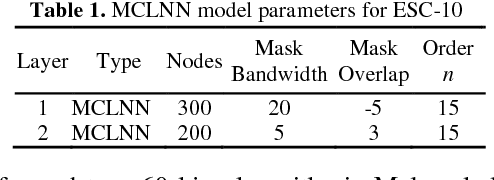

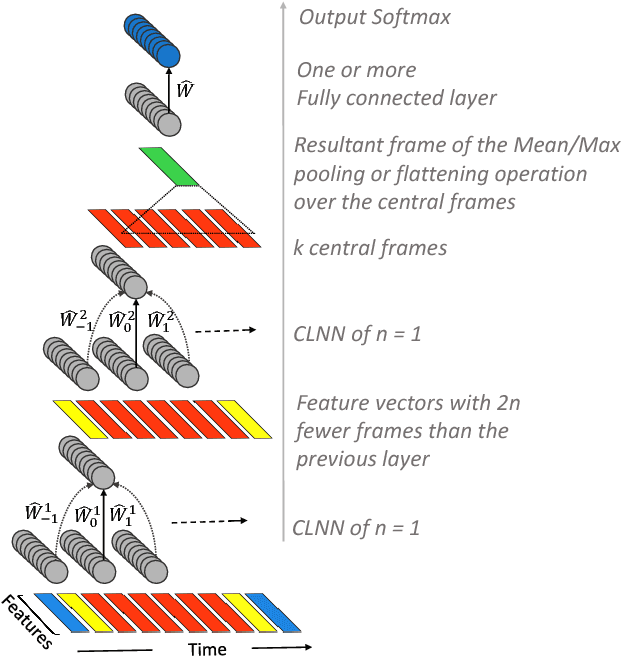

Abstract:Neural network based architectures used for sound recognition are usually adapted from other application domains, which may not harness sound related properties. The ConditionaL Neural Network (CLNN) is designed to consider the relational properties across frames in a temporal signal, and its extension the Masked ConditionaL Neural Network (MCLNN) embeds a filterbank behavior within the network, which enforces the network to learn in frequency bands rather than bins. Additionally, it automates the exploration of different feature combinations analogous to handcrafting the optimum combination of features for a recognition task. We applied the MCLNN to the environmental sounds of the ESC-10 dataset. The MCLNN achieved competitive accuracies compared to state-of-the-art convolutional neural networks and hand-crafted attempts.
Masked Conditional Neural Networks for Audio Classification
Mar 06, 2018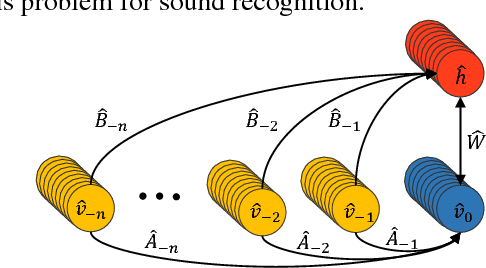
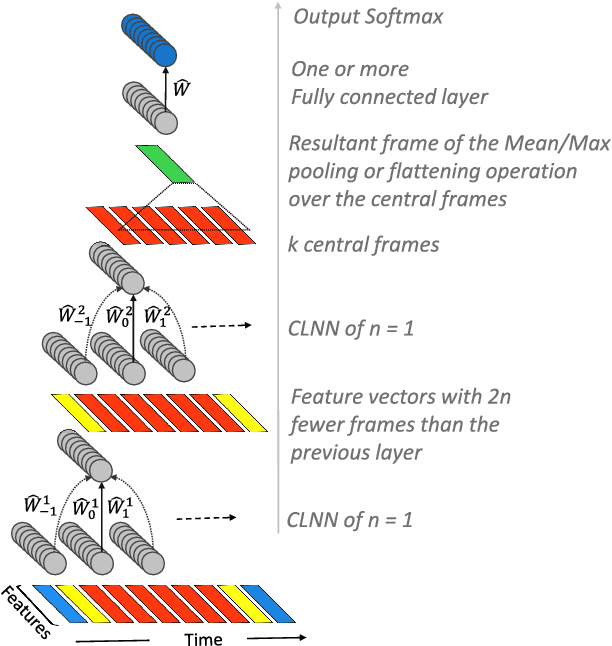

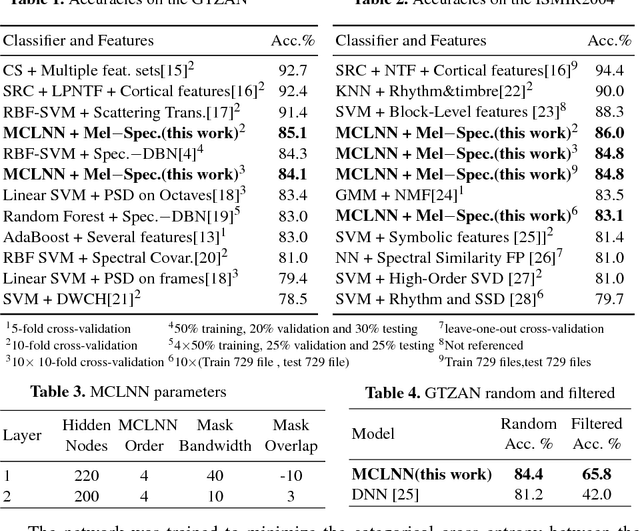
Abstract:We present the ConditionaL Neural Network (CLNN) and the Masked ConditionaL Neural Network (MCLNN) designed for temporal signal recognition. The CLNN takes into consideration the temporal nature of the sound signal and the MCLNN extends upon the CLNN through a binary mask to preserve the spatial locality of the features and allows an automated exploration of the features combination analogous to hand-crafting the most relevant features for the recognition task. MCLNN has achieved competitive recognition accuracies on the GTZAN and the ISMIR2004 music datasets that surpass several state-of-the-art neural network based architectures and hand-crafted methods applied on both datasets.
* Restricted BoltzmannMachine, RBM, Conditional Restricted Boltzmann Machine, CRBM, Music Information Retrieval, MIR, Conditional Neural Network, CLNN, Masked Conditional Neural Network, MCLNN, Deep Neural Network
Music Genre Classification using Masked Conditional Neural Networks
Feb 18, 2018
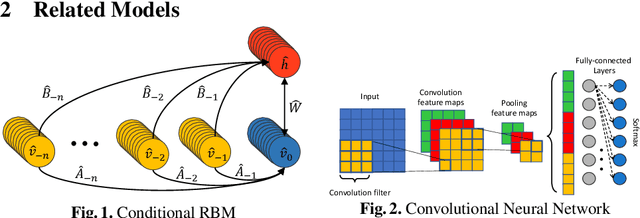
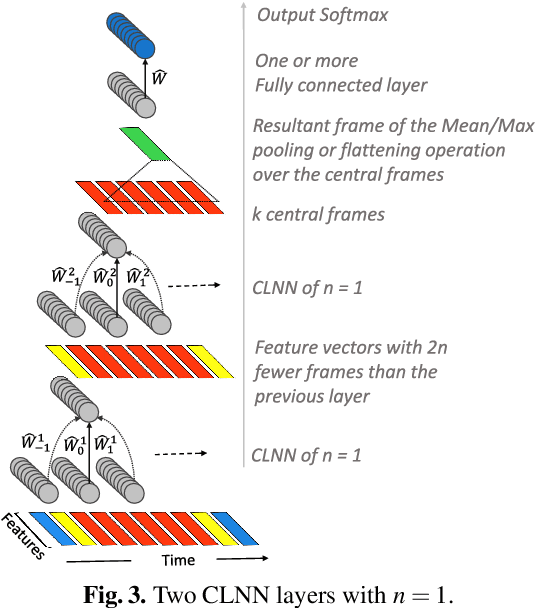

Abstract:The ConditionaL Neural Networks (CLNN) and the Masked ConditionaL Neural Networks (MCLNN) exploit the nature of multi-dimensional temporal signals. The CLNN captures the conditional temporal influence between the frames in a window and the mask in the MCLNN enforces a systematic sparseness that follows a filterbank-like pattern over the network links. The mask induces the network to learn about time-frequency representations in bands, allowing the network to sustain frequency shifts. Additionally, the mask in the MCLNN automates the exploration of a range of feature combinations, usually done through an exhaustive manual search. We have evaluated the MCLNN performance using the Ballroom and Homburg datasets of music genres. MCLNN has achieved accuracies that are competitive to state-of-the-art handcrafted attempts in addition to models based on Convolutional Neural Networks.
* Conditional Neural Networks (CLNN), Masked Conditional Neural Networks (MCLNN), Conditional Restricted Boltzmann Machine (CRBM), Deep Belief Nets (DBN), Music Information Retrieval (MIR)
Masked Conditional Neural Networks for Automatic Sound Events Recognition
Feb 15, 2018



Abstract:Deep neural network architectures designed for application domains other than sound, especially image recognition, may not optimally harness the time-frequency representation when adapted to the sound recognition problem. In this work, we explore the ConditionaL Neural Network (CLNN) and the Masked ConditionaL Neural Network (MCLNN) for multi-dimensional temporal signal recognition. The CLNN considers the inter-frame relationship, and the MCLNN enforces a systematic sparseness over the network's links to enable learning in frequency bands rather than bins allowing the network to be frequency shift invariant mimicking a filterbank. The mask also allows considering several combinations of features concurrently, which is usually handcrafted through exhaustive manual search. We applied the MCLNN to the environmental sound recognition problem using the ESC-10 and ESC-50 datasets. MCLNN achieved competitive performance, using 12% of the parameters and without augmentation, compared to state-of-the-art Convolutional Neural Networks.
* Restricted Boltzmann Machine, RBM, Conditional RBM, CRBM, Deep Belief Net, DBN, Conditional Neural Network, CLNN, Masked Conditional Neural Network, MCLNN, Environmental Sound Recognition, ESR
Recognition of Acoustic Events Using Masked Conditional Neural Networks
Feb 07, 2018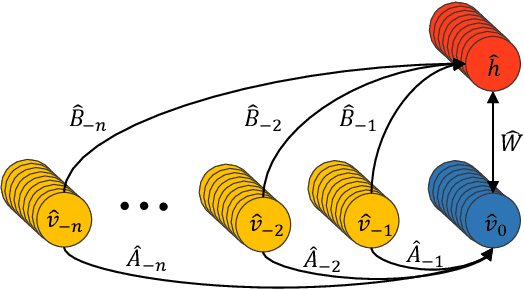
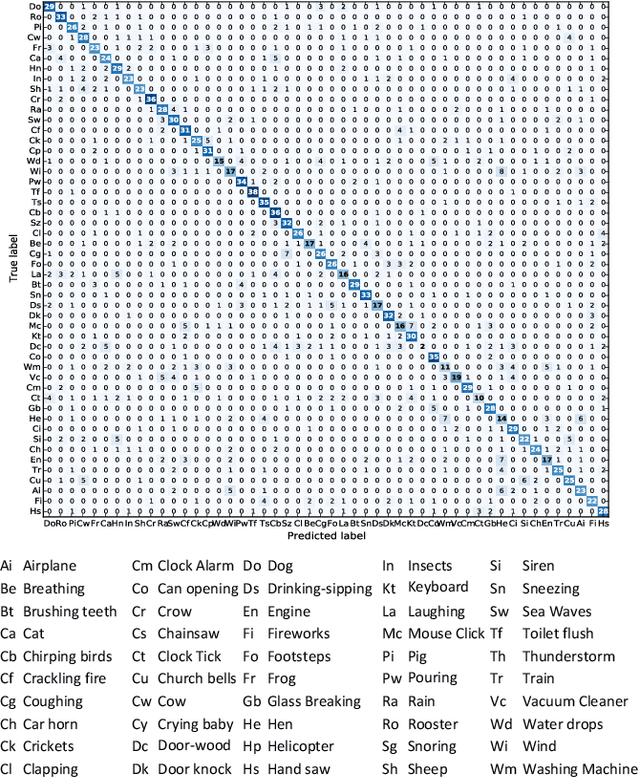


Abstract:Automatic feature extraction using neural networks has accomplished remarkable success for images, but for sound recognition, these models are usually modified to fit the nature of the multi-dimensional temporal representation of the audio signal in spectrograms. This may not efficiently harness the time-frequency representation of the signal. The ConditionaL Neural Network (CLNN) takes into consideration the interrelation between the temporal frames, and the Masked ConditionaL Neural Network (MCLNN) extends upon the CLNN by forcing a systematic sparseness over the network's weights using a binary mask. The masking allows the network to learn about frequency bands rather than bins, mimicking a filterbank used in signal transformations such as MFCC. Additionally, the Mask is designed to consider various combinations of features, which automates the feature hand-crafting process. We applied the MCLNN for the Environmental Sound Recognition problem using the Urbansound8k, YorNoise, ESC-10 and ESC-50 datasets. The MCLNN have achieved competitive performance compared to state-of-the-art Convolutional Neural Networks and hand-crafted attempts.
* Restricted Boltzmann Machine, RBM, Conditional Restricted Boltzmann Machine, CRBM, Conditional Neural Networks, CLNN, Masked Conditional Neural Networks, MCLNN, Deep Neural Network, Environmental Sound Recognition, ESR
Automatic Classification of Music Genre using Masked Conditional Neural Networks
Jan 16, 2018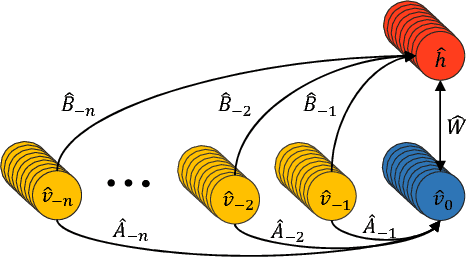
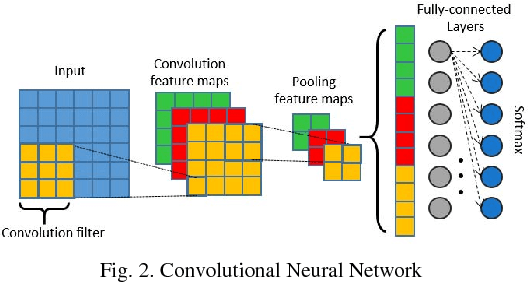
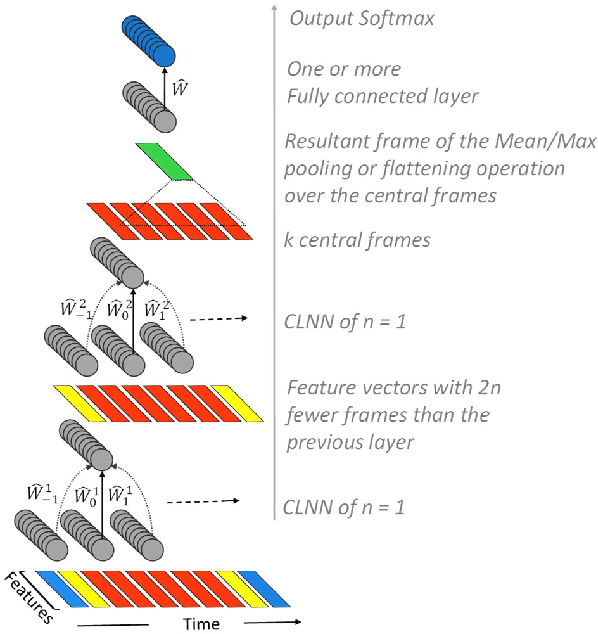

Abstract:Neural network based architectures used for sound recognition are usually adapted from other application domains such as image recognition, which may not harness the time-frequency representation of a signal. The ConditionaL Neural Networks (CLNN) and its extension the Masked ConditionaL Neural Networks (MCLNN) are designed for multidimensional temporal signal recognition. The CLNN is trained over a window of frames to preserve the inter-frame relation, and the MCLNN enforces a systematic sparseness over the network's links that mimics a filterbank-like behavior. The masking operation induces the network to learn in frequency bands, which decreases the network susceptibility to frequency-shifts in time-frequency representations. Additionally, the mask allows an exploration of a range of feature combinations concurrently analogous to the manual handcrafting of the optimum collection of features for a recognition task. MCLNN have achieved competitive performance on the Ballroom music dataset compared to several hand-crafted attempts and outperformed models based on state-of-the-art Convolutional Neural Networks.
* Restricted Boltzmann Machine; RBM; Conditional RBM; CRBM; Deep Belief Net; DBN; Conditional Neural Network; CLNN; Masked Conditional Neural Network; MCLNN; Music Information Retrieval; MIR. IEEE International Conference on Data Mining (ICDM), 2017
 Add to Chrome
Add to Chrome Add to Firefox
Add to Firefox Add to Edge
Add to Edge